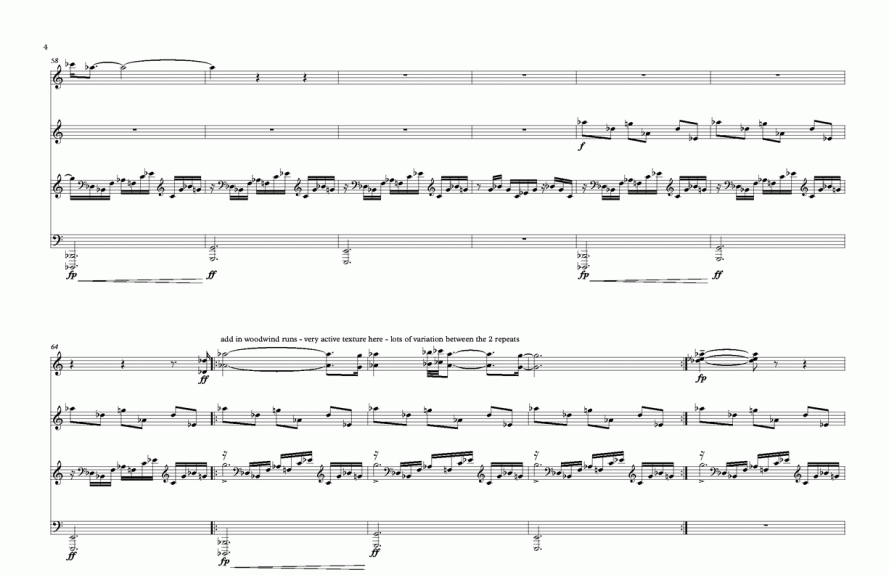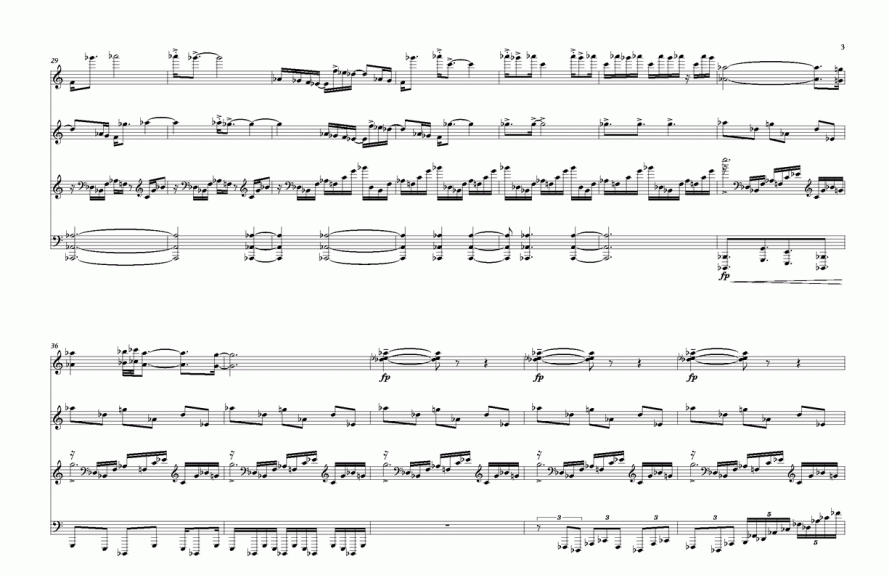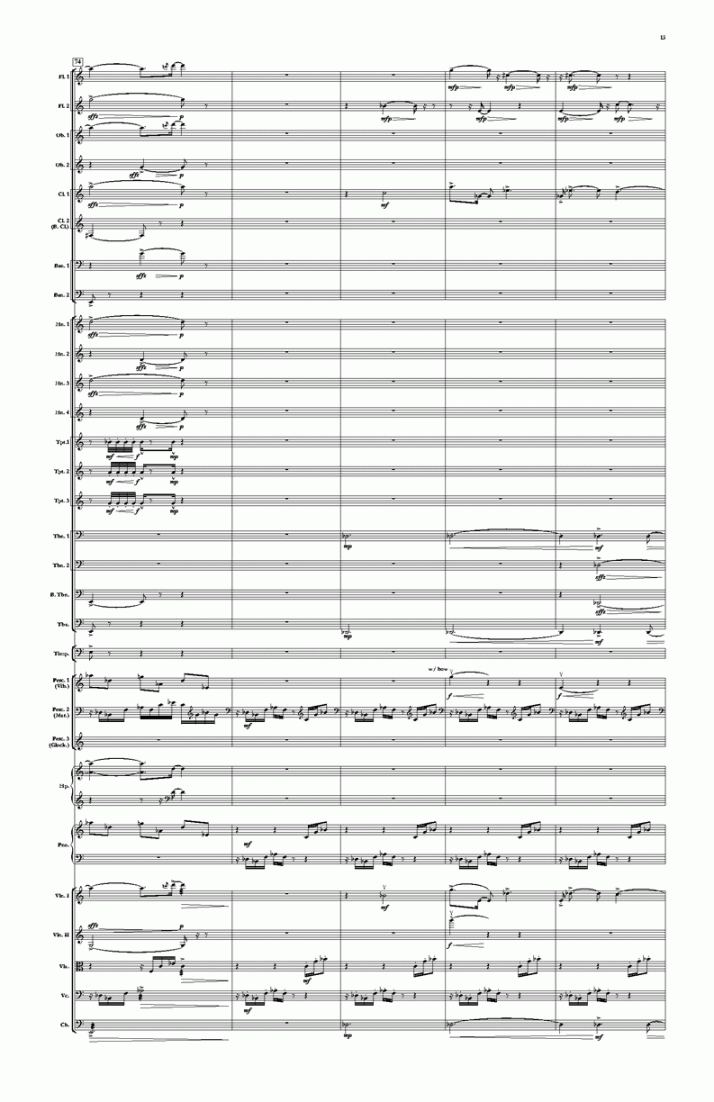May 10, 2013: Today’s post is slightly late. I try to get these posts out each Thursday, but due to some other work related issues (read: finals!) my timing on this post ended up a bit tardy. No matter. I can report today that – once again – great progress was made this week (I feel a bit like a broken record, as each week I mention “steady progress,” “great progress,” etc….we’ll see how long I can keep this up!):
I have finished a fully orchestrated draft of the fourth movement. Huzzah! Time to pop the cork and drink the bubbly! Wait – there are three more movements? And I have to *edit* still? Sigh…better put the champagne back on ice until then.
All giddiness and feigned drama aside, completing the full draft of a movement always feels like a “bittersweet-accomplishment.” There is this wonderful sense of closure, even if it is only for one portion of the whole work. At the same time, there is a groundswell of anticipation as work on the next movement is about to begin. I wonder if authors feel the same way when they complete a chapter, or if comic-book illustrators feel this way every time their character is about to meet certain doom? “Will PLATYPUS-GIRL finally meet her untimely end at the hands of THE TAZMANIAN TRICKSTER? Find out in next week’s issue!” Ok, maybe that last analogy doesn’t work so well – but after I typed it I couldn’t bear to delete it. Just work with me on this.
So, ANYWAYS – let me type a few notes regarding the completion of the fourth movement. The fully orchestrated version of the movement adheres pretty closely to the short-score, with one notable exception. On pages 4 and 5 of the short score, I had sketched out an uptempo middle section that was, quite simply, way too short. So, before orchestrating it I had to return to the short score and extend it considerably – by a full minute (quarter note = 84, in case you are wondering).
Short Score, page 4
Short Score, Page 5
These two pages are from the original short score. It didn’t take long to realize that this had to be edited, as it threw off the pacing and proportion of the entire movement. It has been my experience that great material can take you far in a composition, but if your proportions are off the whole work is ruined. So, the section had to be extended:
Extended Short Score, Page 2 (music inserts in at m. 68, after the repeat sign in the original short score)
Extended Short Score, Page 3 – m. 38 = the old m. 68
And finally, the an excerpt of the orchestrated version of this section:
Movement 4, Orchestrated draft – page 13 (m. 75 corresponds with m. 15 of the extended short score)
Movement 4, Orchestrated draft – page 14
Just a couple screen shots for now – I am planning on sharing the whole movement at some point soon, once it is edited. I’m such a tease…
I find that it is completely normal – and in fact expected – that changes are going to be made in the creative process. A change like the one I just detailed is extremely typical, and illustrates why it is so incredibly necessary to go through multiple drafts before settling in on a final product. To anyone who doesn’t write music, this might sound like a “duh” moment – as in, “Well of course you’re going to have multiple drafts – duh!” After all, this is standard practice when writing, well, anything!
However, in my teaching experience I have noticed a disturbing lack of drafts created by young student composers – and in fact, a resistance to the creation of drafts and sketches. It seems that too often a work is composed, from beginning to end, without taking the time to really consider whether or not the “created” work is in fact incomplete, needs significant editing, requires a reduction of material, or maybe even all of the above! Once the notes are written down – that’s it. They are part of the piece. Imagine if this practice was applied to other disciplines – you turn in your first draft of an essay, or your first draft of a speech, poem, creative writing assignment, artistic sketch…I could go on. As a pedagogue I of course attempt to guide the student, pointing out that which needs to be changed and edited, and hope they make these necessary changes. Sometimes they do, but other times the music remains the same – almost as if the student is simply unable to bear with this admittedly difficult process of change. Much like typing a ridiculous comic-book analogy and then refusing to edit it out.
A large part of this problem stems from the sheer amount of time it takes to compose music. I will admit – I compose fast. I don’t deliberate over every single note for hours on end, but instead spew notes and lines out onto the page, knowing that I will have to make changes later on. The fact is: the more time you invest in your notes, the harder it is to admit that changes to those notes need to be made.”That five measure section that you poured hours and hours into, and have come to love as much as that diseased neighborhood squirrel that you continue to feed despite the fact that it is infecting the whole population? Yeah – it has to go.” (No offense to squirrel lovers…)
It is important to recognize that a draft is simply that – a draft. It WILL change, and that is OK. Original concepts and sketches are not shackles to be worn at all times, even to the detriment of the work. If throughout the creative process a new idea requires that a change be made, or perhaps an idea is completely retired, then so be it. Let the creative process work.
On that note, let me come to my second major change, one that is in fact related directly to the concept of the whole work. A few blog posts ago I discussed how the whole Symphony would relate to the concept of “conversation.” However, beyond this movement – which as I said earlier is modeled after an intimate and intense dialog – I felt as if I was struggling to create music that didn’t feel constrained by this concept. So, another change: instead of “conversation,” I am moving laterally to the concept of “dialog.” While these two concepts are related, the word “dialog” is both a bit more refined and at the same time opens up all sorts of musical possibilities. In particular, it gives me a couple new creative approaches for the first and third movements. The first movement – instead of being a “neurotic conversation with one-self” – will be modeled after an “inner-dialog.” I intend to compose my ideas as atmospheric and ephemeral gestures that will on occasion move into focus, after which they will be allowed to drift away as other musical ideas are concentrated on. This abstract approach will allow for a greater focus on color as I attempt to create an intangible web representing my own thoughts (this could potentially be very, very scary…). Conversely, the third movement will directly approach the word “dialog” from a completely musical perspective, using it to reference the jazz practice of “trading fours.” This practice occurs when the drummer and each member of the band alternate solos in four-bar increments. In other words, I will attempt to compose an all-out trading-fours orchestral jam session! My jazz roots are showing.
The second movement…well, I’m still working on that one. Depending on how these other two movements go, maybe this will end up as a three movement symphony. One more change wouldn’t hurt, right?





